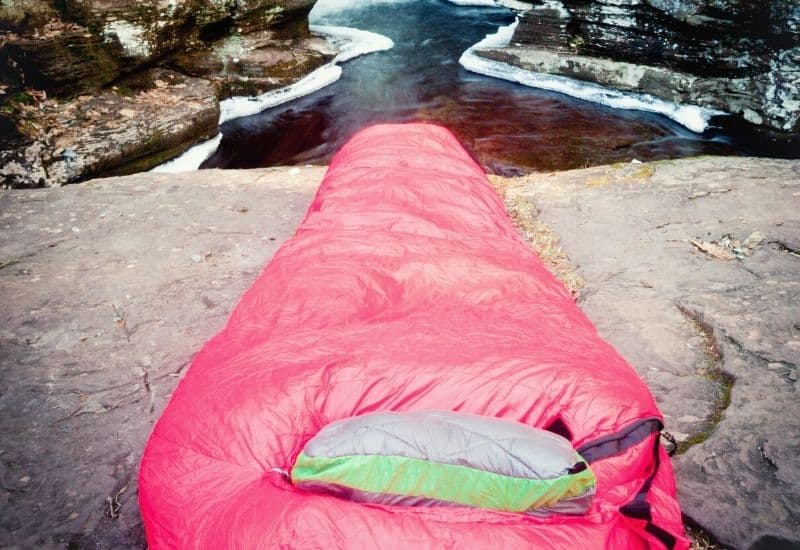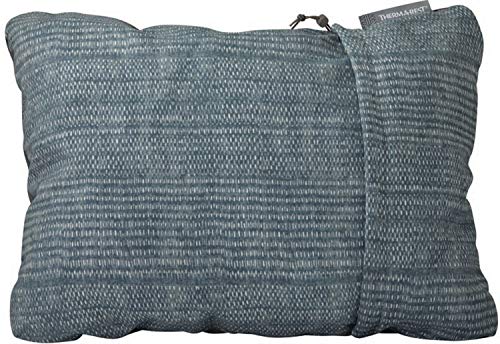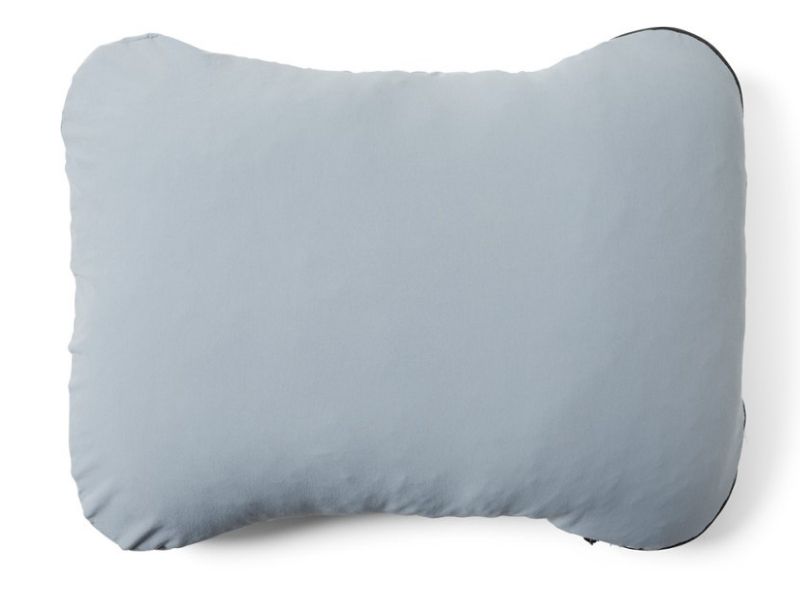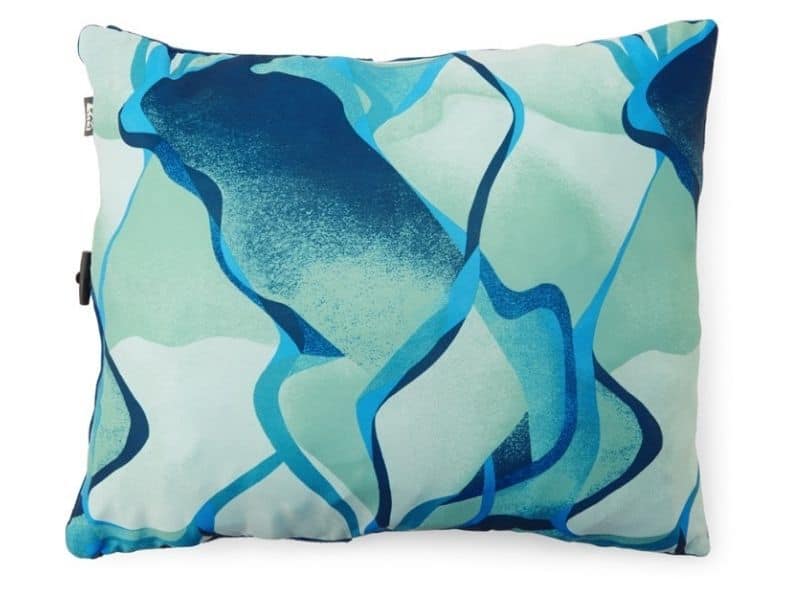After a long day of hiking and setting up camp, there’s nothing worse than not getting a restful night of shuteye under the canvas. Besides a quality sleeping bag and pad, another essential item that can elevate your backcountry bedtime experience from restless to home-like is the humble yet invaluable backpacking or camping pillow.
We found the Sea to Summit Aeros Down to be our most favored option but depending on your circumstances we’d also recommend the Therm-a-Rest Compressible, HEST Camping Pillow, Nemo Fillo Elite, Nemo Fillo, Sea to Summit Aeros Premium, REI Co-op Trailbreak, Therm-a-Rest Trekker, and the Exped Air Pillow UL.
Alongside reviews of these 9 awesome pillows, we also offer comprehensive advice to help you find the best option within your budget. One consideration to be made is in selecting between inflatable, compressible, hybrid, or stuff sack models. Additionally, you’ll need to decide what to prioritize in your backpacking pillow from comfort & support, weight & packed size, ease of use, and durability.
Table of Contents
At a Glance: Best Camping Pillow
-
Editor’s Choice:
Sea to Summit Aeros Down
“An ultralight, superbly comfortable hybrid pillow that provides plenty of support and the added luxury of a cozy down topper.” -
Best Value:
Therm-a-Rest Compressible
“A slightly heavy but affordable, well-made, and comfortable compressible pillow made with recycled materials.” -
Best Budget:
REI Co-op Trailbreak
“A basic but surprisingly comfortable and well-made option at an affordable price.” -
Best for Car Camping:
HEST Pillow
“This luxury pillow is too heavy and bulky for backpacking, but ideal for roadside campers unwilling to compromise on comfort.” -
Best Hybrid Pillow:
Nemo Fillo Elite
“A slightly skinny but otherwise awesome hybrid pillow that combines an ergonomic air chamber with a plush Primaloft topper for a supportive and more homely feel.” -
Best Support:
Nemo Fillo
“This hybrid model combines I-beam air cells with a luxury foam fill to deliver a little extra resilience and firmness.” -
Best Inflatable Pillow:
Sea to Summit Aeros Premium
“The Aeros’ ultralight weight and super-soft face fabric make it a good backpacking pillow for anyone who wants the packability of an inflatable without compromising too much on comfort.” -
Best Stuff Sack Pillow:
Therm-a-Rest Trekker
“A wonderfully soft, uber-practical liner that lets you save precious pack space for other things.” -
Best Ultralight:
Exped Air Pillow UL
“The Air UL’s ultralight weight, tiny packed size, and durable fabric make it the perfect pick for long-term backcountry travel.”
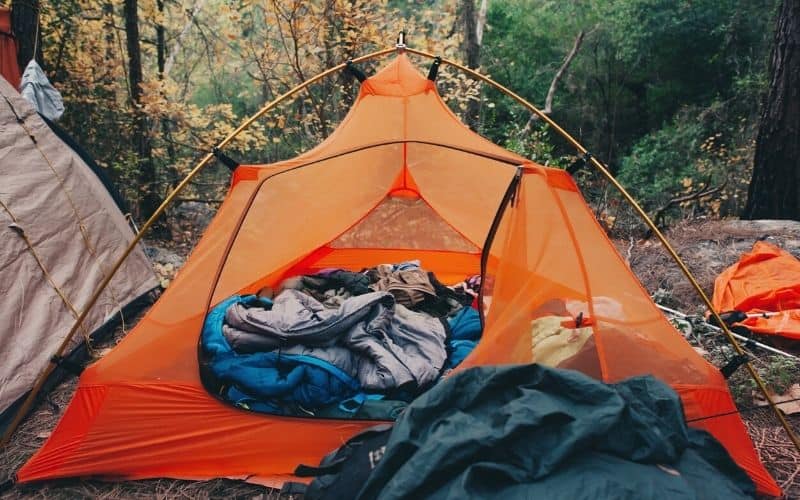
What Are The Best Camping Pillows?
Out of our best backpacking pillows shortlisted below the the Sea to Summit Aeros Down came out on top.
- Sea to Summit Aeros Down
- Therm-a-Rest Compressible
- HEST Camping Pillow
- Nemo Fillo Elite
- Nemo Fillo
- Sea to Summit Aeros Premium
- REI Co-op Trailbreak
- Therm-a-Rest Trekker
- Exped Air Pillow UL
Sea to Summit Aeros Down
Editor’s ChoiceRegardless of your sleeping preferences or trip type, the Sea to Summit Aeros Down emerges as our editor’s choice, offering exceptional comfort, support, and weight savings.
Combining a thermoplastic urethane inflatable bladder with a luxurious down topper, the Aeros marries the best bits of inflatable and compressible styles of pillows. The bladder provides ample support even for side sleepers and the warm, lofty down topper offers comfort levels on a par with compressible models that weigh 5 times more.
That, in a nutshell, is the Aeros’ genius and the USP that makes it well worth its slightly inflated price tag.
And it gets better. Most inflatable and hybrids get a bad rep for sliding around while you sleep or being prone to punctures, but not the Aeros. It’s made with robust 20d underside fabric for added durability and employs S2S’s nifty PillowLock system to ensure it stays where you want it throughout the night.
You’re probably wondering if the above couldn’t be said of all hybrid-style backpacking pillows. And yes, it’s true that most hybrids tick the support and comfort boxes whilst also keeping weight to a minimum. However, the Aeros’ down fill and use of horizontal baffles that maximize loft make it a true standout even compared to the top competitors in the ultralight hybrid category.
In a head-to-head with our list’s other hybrid, the Nemo Fillo Elite, the Aeros came up trumps on account of its added height and lighter weight at 2.5 oz. If you’re a back sleeper, however, and are happy to carry those 5 extra ounces to save a few $, then the Fillo Elite’s a solid alternative.
PROs
- Lightweight
- Tough underside
- Responsibly sourced down fill
- Great support
- Very comfortable
CONs
- Pricey
Bottom-Line: This soft, lightweight pillow offers awesome support and just-like-home comfort making it well worth the added expense.
Therm-a-Rest Compressible
Best ValueIf you’re looking for an affordable pillow that falls between an ultralight backpacking pillow and a more substantial car-camping pillow, the Therm-a-Rest Compressible could be the ideal solution for you.
Weighing in at 9 oz., this is the lightest compressible pillow on our list. Sure, it isn’t going to win any prizes for featheriness, but it isn’t going to break your back on a multi-day backpacking trip either.
The important thing here, of course, is that the latter is something that can rarely be said of compressible-style pillows – cast your eye toward the specs of the HEST Pillow (below) and you’ll see what we mean!
Compared to ultralight air pillows like the Exped Air or Nemo Fillo, the Therm-a-Rest delivers what you’d expect from a compressible. It’s more durable, softer, and offers better next-to-skin comfort. It also, however, takes up a lot more room in your pack and is 3-4 times heavier.
Weight and packed size aside, this pillow does a lot to endear. It has a soft foam filling that feels amazingly home-like, a brushed polyester shell, and measures a generous 18 x 14 x 4 inches. It’s also made entirely with recycled materials and comes with a reassuring 2-year warranty.
PROs
- Comfortable
- Affordable
- Lightweight for a compressible
- Durable fabric
CONs
- A little heavy for multi-day backpacking
Bottom-Line: A great pillow for anyone who wants the comfort of a compressible without such a prohibitive weight penalty
HEST Camping Pillow
Best for Car CampingFor car camping, the HEST is certainly a contender to consider, offering the comfort and coziness akin to the pillow you use at home.
This beast of a pillow is the heaviest and bulkiest on our list – by a large margin. Unless you happen to have a packhorse or personal Sherpa to haul your gear for you, then, it’s far from ideal for backpacking.
But not all of us plan on venturing far and wide before setting up camp.
If you do most of your camping at roadside sites or from the back of your SUV, the HEST’s heft and oversized dimensions are, in fact, a bit of a boon. They make it more supportive than the vast majority of its peers, as comfy as they come, extra-durable, and far less likely to slip out from under your head.
But the HEST has a lot more going for it than size alone.
Its shredded memory foam and polyester fill mean it won’t flatten or lose its shape during the night, while zippered access to the fill allows you to customize the level of loft to your preference or sleep style. Unlike most pillows of this size, it also has a curved, ergonomic shape that sits snugly under your head and neck.
To top it all off, the HEST uses a stretch-woven face fabric cover that’s soft against the skin, provides plenty of airflow, and is both water- and dirt-resistant.
PROs
- Huge!
- Comfortable
- Ergonomic shape
- Durable
- Integrated stuff sack
CONs
- Huge!
- Heavy
- Expensive
Bottom-Line: Too heavy for backpacking, but an ideal pick for roadside camping if you want home-like comfort and are happy to pay for the privilege.
Nemo Fillo Elite
Best Hybrid PillowThe Nemo Fillo Elite is our top choice for a hybrid backpacking pillow, being ultralight, highly packable, and incredibly comfortable, and all at a more affordable price compared to most others.
It’s made with a winning combo of I-beam baffled air cells and a thin layer of Primaloft insulation, which together provide ample support and oodles of comfort. The fill is also topped off with a soft jersey cover that’s machine washable, cools the skin, and feels frickin’ marvelous against the skin.
Wondering why this didn’t win the award of best overall backpacking pillow overall?
Well, it might seem like we’re splitting hairs, but there are a few (potential) downsides.
The most obvious of these is the Fillo’s slender proportions – at 3” thick, this is the slimmest pillow on our list and therefore not ideal for side sleepers. And compared to the Aeros Down, the Fillo’s less substantial base fabric did leave us wondering how long it would last if subjected to the odd spiky root or sharp rock around camp.
Specs
- Type: Hybrid
- Weight: 3 oz.
PROs
- Cozy Primaloft synthetic-fill insulation
- Soft face fabric
- Tiny packed size
- Made with recycled materials
- Fits inside sleeping bag hood
CONs
- Only 3” thick (great if you prefer flat pillows!)
- Kinda pricey (but not bad for a hybrid!)
Bottom-Line: One of the most comfortable backpacking pillows out there for stomach and back sleepers.
Nemo Fillo
Best SupportIf you’re tired of flat camping pillows or hard inflatables that leave you with a stiff neck come sunrise, the Nemo Fillo provides the best support among the pillows we tested.
The above is a bold claim but the Fillo is, without doubt, the most supportive of all the inflatable, hybrid, or foam pillows we’ve ever tried.
Here’s why.
The Fillo combines a tough air bladder base with a generously thick foam topper, providing you with 4 inches of firm but comfortable loft. There are thicker pillows out there, sure, but the foam used in this one offered just a little more “resilience” without feeling more like a basketball than something designed to let us sleep comfortably.
It also has a nice ergonomically shaped I-beam baffled air cell, an incredibly soft microsuede cover, and packs down to a bundle the size of a tennis ball,
The Nemo Fillo’s 9-oz. weight makes it less suitable for long backpacking trips than other pillows on our list. But for roadside camping, travel, or shorter backpacking adventures, it’s a great choice.
Specs
- Type: Hybrid
- Weight: 9 oz.
PROs
- Luxury foam fill
- Machine-washable microsuede cover
- 17” wide
- Baffled air chamber reduces “balloon” feeling
CONs
- Quite heavy
Bottom-Line: A luxury pillow that provides a little extra width and the added support that side sleepers require.
Sea to Summit Aeros Premium Pillow
Best Inflatable PillowIf you prefer to pack fast and light, we recommend the Sea to Summit Aeros Premium as the top choice for an inflatable backpacking pillow.
Weighing just 2.7 oz., the Aeros Premium is only 0.7 oz heavier than the lightest pillow on our list, the Exped Air UL. As with all inflatables, both of these pillows are a little squeaky, prone to slipping, and a little hard under the head. But if you prefer a firm pillow and a little more loft, both are solid options.
If forced to choose between the two, we’d park ourselves firmly on the fence. For ounce-counters, the Exped’s naturally a better choice given that it’s a whole 4.7” wider. If durability is more of a concern, then the Aeros is your best bet – its 50D fabric is much more likely to survive rough treatment around camp than the Exped’s 20D stretch polyester.
You might be wondering what differentiates the Aeros from the countless other worthy inflatables on the market.
For starters, we love the Aeros’ ergonomic design. The top is contoured in a way that cradles the head, which makes it a little more stable than other inflatables.
Secondly, the mini-valve via which inflating’s done through allows you to adjust the level of loft with ease, without a headlamp or even having to raise your head.
Finally, the Aeros’ unique PillowLock system keeps your pillow exactly where it belongs when used in combination with an S2S sleeping pad, eliminating the most commonly cited drawback of nearly all inflatable-style backpacking pillows. The pad isn’t included, of course, but if you need an excuse to buy one…
Specs
- Type: Inflatable
- Weight: 2.7 oz.
PROs
- Lightweight
- Adjustable
- Tough fabric
- Ergonomic design
- Lock system attaches to S2S sleeping pads
CONs
- A little bit wobbly
- Not as comfortable as a compressible or hybrid pillow
Bottom-Line: A tough, lightweight backpacking pillow that’s ideal for buyers who want the added support and packability of an inflatable without sacrificing too much in the way of comfort or durability.
REI Co-op Trailbreak
Best BudgetFor a high-quality, foam pillow that ticks all the boxes on a budget, we love the REI Co-Op Trailbreak.
The Trailbreak is one of the most popular backpacking and camping pillows on the market. And with good reason.
The Trailbreak is made with upcycled scraps of foam that REI Co-Op use to make their self-inflating sleeping pads, which, handily, makes it one of very few self-inflating pillows on the market. When it’s time for bed, all you have to do is pull it out of the storage pocket and watch as it transforms from a tennis-ball-sized bundle into a plush cushion five times its packed size.
Pretty neat, right?
Compared to its closest compressible competitor, the Therm-a-Rest Compressible, the Trailbreak’s an ounce heavier at 10 oz., but also a little more affordable and packs down to a smaller size.
PROs
- Affordable
- Made with upcycled foam
- Small packed size
- “Self-inflating”
- Measures 18” x 14”
CONs
- Heavy
Bottom-Line: A nicely priced, highly packable, and generously sized self-inflatable pillow that’s ideal for buyers who want the comfort of a compressible without paying through the nose.
Therm-a-Rest Trekker
Best Stuff Sack PillowThe Therm-a-Rest Trekker is our go-to backpacking stuff sack pillow for multi-day trips when pack space is limited.
This pillow packs down to the size of a large handkerchief and can easily fit inside a shirt pocket. When opened, however, it measures a healthy 17” x 14”, making it one of the largest camping pillows on our list.
But how does it work? Well, as with all stuff sack pillows, the Trekker relies on your extra clothing for its loft, so we wouldn’t recommend it if you’re on a backpacking trip with your nudist colony or if you like to sleep in all the clothing you carry. (We tried filling ours with leaves once, but wouldn’t recommend it!)
What we love most about this sack is that it weighs next to nothing but, thanks to its plush, brushed polyester exterior, allows us to enjoy a perfectly pillow-like experience without having to carry a separate pillow along for the trip. And when we’re done with it in the a.m., we can also put it to work as a standard stuff sack for other bits of gear.
Gotta love gear that’s multifunctional, right?
Specs
- Type: Stuff sack
- Weight: 2.3 oz.
PROs
- Ultralight
- Doubles as a stuff sack for other gear in daytime
- Tiny packed size
- Brushed polyester face fabric
- 2-year warranty
CONs
- Comfort depends on what you fill it with
Bottom-Line: A great choice for backpackers happy to sleep on a makeshift pillow if it means saving precious cubic inches in their pack.
Exped Air Pillow UL
Best Ultralight Backpacking PillowThe Exped Air UL is ideal for backpackers and thru-hikers seeking a durable, thick pillow that provides ample support at an ultralight weight.
Tipping the scales at just 2 oz., this is the lightest blow-up pillow on our list. But there are several other reasons why the Air UL has made a habit of picking up “Top Backpacking Pillow” awards over the years.
For starters: it may be a featherweight, but it’s far from flimsy. While the Air UL’s 20D fabric makes it less robust than the Aeros Premium, it’s more than tough enough to deal with regular use and abuse.
Secondly, this is a large pillow – measuring 18.1” x 11.8” x 4.7”, it’s one of the widest and thickest pillows on our list, which makes it ideal for side sleepers.
Finally, if you’re a stomach or back sleeper, the Air UL’s low-profile FlatValve makes adjusting loft a cinch, while the anatomical shape means your head will be comfortably cradled and held in place no matter how much (or how little) you inflate it.
Specs
- Type: Inflatable
- Weight: 2 oz.
PROs
- Ultralight
- 20D fabric
- Soft face fabric
- 5-year warranty
CONs
- Less comfortable than compressible and hybrid pillows
- Pricey for an inflatable
- A bit noisy
Bottom-Line: Light, large, comfortable, reasonably durable, and our favorite camping pillow for multi-day adventures.
What Is The Best Camp Pillow Type For You?
Backpacking pillows are more complex than they appear, with various styles differing significantly in terms of comfort, support, and suitability for the trail. We’ve listed the main types below.
- Inflatable
- Compressible
- Hybrid
- Stuff Sack
Inflatable
Since air weighs almost nothing, inflatable pillows are popular with backpackers aiming to shave ounces off their pack load. They can offer the loft of the densest, heaviest fabrics without compromising on support.
Inflatable pillows are also highly packable and in many cases far cheaper than compressible or hybrid models.
There are however several drawbacks. What goes up, must/might come down, and inflatable pillows are the only type that will come down (i.e. deflate) when punctured. They’re also a little wobbly and unstable as compared to a compressible pillow or stuff sack, and not nearly as soft.
That said, some inflatables, like the Sea to Summit Aeros, use nifty locking systems or anti-slip surfaces to help keep them in place. And all of them, of course, can be deflated to the level of firmness you desire.
Our list includes 2 inflatables, the S2S Aeros Premium and Exped Air UL.
Compressible
To resemble your home pillows, a compressible pillow is filled with materials that compress and expand, such as shredded foam or compressible fiber. While this makes them bulky and heavy, it also makes them the most comfortable and supportive option.
As you might imagine, compressibles’ weight and size make them less than ideal for backpacking. If you’re car camping, however, or are willing to lug a few extra ounces in return for a little luxury and superior comfort, then this is the type of pillow you need.
Our list has 3 compressible pillows: the Therm-a-Rest Compressible, HEST, and REI Co-op Trailbreak.
Hybrid
These pillows use a combo of compressible materials and air to provide a happy medium between an inflatable and compressible pillow. In most cases, this takes the form of a lower inflatable bladder topped with a soft, upper layer of down or foam insulation that enhances comfort.
This design makes hybrids more comfortable than inflatables, but also heavier and equally prone to punctures. They’re also lighter than compressibles but can be pricier.
There are 3 hybrids on our list: the Nemo Fillo, Nemo Fillo Elite, and S2S Aeros Down.
Stuff Sack
Stuff sack pillows are designed based on roll-top-closure bags used for gear storage, only they have a soft, brushed surface fabric for next-to-skin comfort. Come bedtime, you simply stuff them with a jacket, sweater, or other extra clothes, seal them up, and you’re all set to snooze.
The ultralight weight of a stuff sack pillow makes them a shoo-in for ultralight adventures, whether you’re thru-hiking or simply prefer to lug less burdensome loads. Moreover, unlike inflatables, they can’t be punctured, and also serve as a handy stuff sack for other gear during the daytime.
The downside: these pillows, of course, will only be as comfortable as the materials you stuff them with.
Our list has only one stuff-sack pillow, the Therm-a-Rest Trekker. While there are plenty of good competitor models out there, this one’s fair pricing, comfort, and intelligent design made it a standout.
What Features To Look For In A Good Backpack Pillow?
To help you decide what style suits your needs best the following list shows what features to look out for in backpacking pillows.
- Comfort & Support
- Weight & Packed Size
- Ease of Use
- Durability
Comfort & Support
All the pillows in our review delivered on the two core competencies for pillows, comfort and support. However, certain models cater to specific types of sleepers better than others, with some offering superior support and comfort.
Here’s how to determine which will be best for you:
Side sleeper? If so, you’ll need a little more height to support your neck and shoulders, which makes inflatables and hybrids the best option. A stuff-sack pillow will work well too, but only, of course, if you have something substantial to fill it with.
Back sleeper? In this case, a lower-profile pillow is usually preferable, which means any style of pillow might be a good match (even inflatables can be deflated to the desired height). That said, most back sleepers – and stomach sleepers – prefer the malleability of a compressible.
Generally speaking, we find compressibles and hybrids are the most comfortable of the bunch because they most closely mimic the coziness and loft of our pillows at home, especially when filled with down feathers.
Whichever style you choose, the next most important factor is the “face fabric” – i.e. the portion of the pillow that will be in contact with your phizog. The comfiest face fabric? Brushed polyester is the fabric of choice in many backpacking pillows on account of its soft feel and ability to absorb moisture. Because nylon can be slippery or sticky, it’s best avoided.
We also prefer an ergonomically shaped or contoured pillow, like the Aeros and Exped Air. These provide better support for the neck and back and are also less likely to slip around while you sleep.

Weight & Packed Size
For car camping, the weight and packed size of your pillow are not significant considerations, but for backpackers, they are a critical concern.
If your vehicle – rather than your legs – is responsible for carting your kit to your campsite, then you can afford to plump for a more comfortable pillow, weight and packed size be damned.
If you’re backcountry camping, however, you want a hiking pillow that strikes the optimal balance between comfort, support, poundage, and packability.
What kinda pillow does that best? Inflatable and stuff sack pillows are good choices because they weigh almost zip and pack down super-small. But bear in mind these styles often entail sacrificing the comfort and support of a hybrid or compressible.
The lightest and most packable options on our list are the Therm-a-Rest Trekker (2.3 oz.) and Exped Air (2 oz.).
The weight of the compressibles above varies widely, from the relatively lightweight Therm-a-Rest Compressible (9 oz.) to the kinda cumbersome HEST (35.2 oz).
How to choose the best pillow for you? It’s all about deciding how much comfort you’re willing to trade for weight savings.
Ease of Use
When it comes to backpacking pillows ease of use refers to three factors: 1) ease of deploying the pillow; 2) ease of cleaning it; 3) ease of sleeping on it.
- Deployment: Short on patience? If so, then you probably don’t want an inflatable backpacking pillow that requires you to sacrifice around two minutes of your time to transform it from pouch to pillow, so the ready-to-roll configuration of a compressible pillow will be more suitable for you.
- Cleaning: Machine-washable models like the Therm-A-Rest Compressible and Nemo Fillo are ideal if you’re the type of camper who concerns themselves with things like hygiene. Most inflatables, on the other hand, can only be wiped clean.
- Staying Power: Many pillows, especially inflatable ones, tend to slide out from under your head while you sleep. This, of course, sucks. Some manufacturers get around this by adding locking systems (see: S2S Aeros & Aeros Down), non-slip fabric, or contoured undersides that help keep them in place.
If you’re a card-carrying tosser and turner, however, compressibles and stuff sacks are the type least likely to go AWOL throughout the night.
Durability
The most important factor for durability is the fabric density of the pillow. Fabric density, or thickness, is measured in “Denier,” often seen in product specifications as a singular “D,” such as “20D,” “50D,” and so on. A higher denier count indicates a more durable product, so consider models with 20-50D fabric for increased longevity.
Make no mistake about it, the great outdoors is no place for flimsy, feeble fabrics. Rocks, trees, roots, foliage, twigs, crampons, tent poles, tent pegs, and clumsy campmates are just a few of the things that could send your pillow prematurely to pillow heaven if it ain’t made with materials that cut the mustard.
